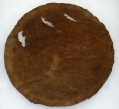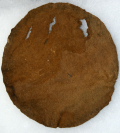site search
online catalog
KEPI CROWN FROM FORT PEMBINA, NORTH DAKOTA

$100.00
Quantity Available: 1
Item Code: 1052-430
Shipping: Determined by Method & Location of buyer
To Order:
Call 717-334-0347,
Fax 717-334-5016, or E-mail
This crown from a soldier’s kepi comes from excavations at Fort Pembina, ND, and shows three oval holes and one small slit, with some edge wear and stains. The color has shifted from blue to brown, but one side still shows a bit lighter around the edge where the side panels of the cap would have rolled over and protected it. The excavations were conducted on private property with the owner’s permission, and the soil conditions have preserved both leather and cloth, some in remarkably good condition. The fort was established in 1870 by troops of the 20th US Infantry and garrisoned until 1895 and as would be expected from an early Indian War post, show a mix of Civil War commercial and issue items retained by soldiers, sold by retailers from old inventory, or issued by the army out of surplus stocks, along with later material, both commercial and issue.
Situated in the Red River Valley in North Dakota near the Canadian border, Fort Pembina was established in 1870 and in operation until 1895. Trading posts existed earlier in the area as part of the fur trade, and the first U.S. military post there was temporary- manned by a detachment of Minnesota troops in 1863-1864 following the 1862 Sioux uprising. In March 1870 a new fort was established south of the Pembina River and about 200 yards west of the Red River, completed by July and named in honor of Gen. George H. Thomas. The name was changed to Fort Pembina in September and the initial garrison consisted of two companies of the 20th US Infantry. Their main duty was to provide security for settlers worried about Sioux returning south from Canada, escort boundary surveys along the Canadian border, and, ironically, prevent raids north into Canada by Fenian groups.
The fort included enlistedmen’s barracks, officers’ quarters, guard house, ordnance storehouse, company kitchen, root house, laundress’s quarters, quarters for civilian employees, hospital and hospital servant’s house, a barn for the “hospital cow,” quartermaster and commissary offices and storehouse, stables, wagon shed, etc. The garrison reached peak strength in 1878 of 200, but the average was about 125 enlisted men and 8 officers. An October 1885 return listed 97 men, 2 field pieces, 1 mountain howitzer, 100 rifles, 19 pistols, 23 mules, and 9 wagons. By 1890 the post had just 23 men, and after an 1895 fire destroyed some 19 buildings it was decided to abandon the fort rather than rebuild, the last detachment left in September. The property was turned over to the Interior Department and later sold in 1902. [sr] [ph:L]
~~~~~~~~~~~~~~~~~~~~~~~~~~~~~~~~~~~
THIS ITEM, AS WITH ALL OTHER ITEMS AVAILABLE ON OUR WEB SITE,
MAY BE PURCHASED THROUGH OUR LAYAWAY PROGRAM.
CLICK HERE FOR OUR POLICIES AND TERMS.
THANK YOU!
Inquire About KEPI CROWN FROM FORT PEMBINA, NORTH DAKOTA
For inquiries, please email us at [email protected]
Most Popular
Historical Firearms Stolen From The National Civil War Museum In Harrisburg, Pa »
Theft From Gravesite Of Gen. John Reynolds »
Selection Of Unframed Prints By Don Troiani »
Fine Condition Brass Infantry Bugle Insignia »
British Imported, Confederate Used Bayonet »
Scarce New Model 1865 Sharps Still In Percussion Near Factory New »
featured item
ALS, MAJOR GENERAL JAMES LONGSTREET, CSA, Addressed To MAJOR GEN. DANIEL HARVEY HILL
Dated “Hd Qrs June 16th 1862.” One page in ink, 5” x 8. Exhibits fold-marks. Else VG and entirely legible. This letter from one major general divisional commander to was written between between the Battle of Fair Oaks at the end of May 1862 and… (1179-1398). Learn More »
site search
Upcoming Events
May 16 - 18: N-SSA Spring Nationals, Fort Shenandoah, Winchester, VA Learn More »




